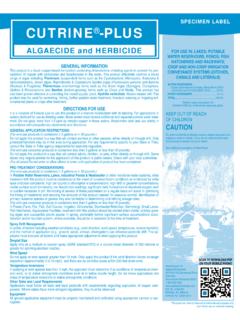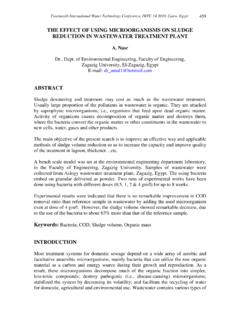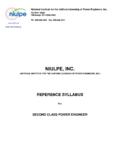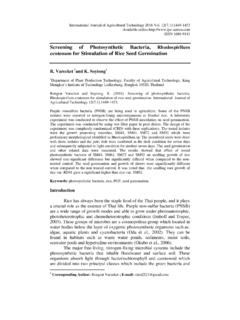Transcription of Effect of indigo dye effluent on the growth, biomass ...
1 An Acad Bras Cienc (2014) 86 (1)Anais da Academia Brasileira de Ci ncias (2014) 86(1):(Annals of the Brazilian Academy of Sciences)Printed version ISSN 0001-3765 / Online version ISSN of indigo dye effluent on the growth, biomass production and phenotypic plasticity of Scenedesmus quadricauda (Chlorococcales)MATHIAS A. CHIA1 and RILWAN I. MUSA21 Laborat rio de Cianobact rias, Escola Superior de Agricultura Luiz de Queiroz, Universidade de S o Paulo, Av. P dua Dias, 11, 13418-900 Piracicaba, SP, Brasil2 Department of Biological Sciences, Ahmadu Bello University, zaria, Postal Code 810001, NigeriaManuscript received on June 26, 2013; accepted for publication on October 14, 2013 ABSTRACTThe Effect of indigo dye effluent on the freshwater microalga Scenedesmus quadricauda ABU12 was investigated under controlled laboratory conditions. The microalga was exposed to different concentrations of the effluent obtained by diluting the dye effluent from 100 to 175 times in bold basal medium (BBM).
2 The growth rate of the microalga decreased as indigo dye effluent concentration increased (p < ). The EC50 was found to be 166 dilution factor of the effluent . Chlorophyll a, cell density and dry weight production as biomarkers were negatively affected by high indigo dye effluent concentration, their levels were higher at low effluent concentrations (p < ). Changes in coenobia size significantly correlated with the dye effluent concentration. A shift from large to small coenobia with increasing indigo dye effluent concentration was obtained. We conclude that even at low concentrations; effluents from textile industrial processes that use indigo dye are capable of significantly reducing the growth and biomass production, in addition to altering the morphological characteristics of the freshwater microalga S. quadricauda. The systematic reduction in the number of cells per coenobium observed in this study further confirms that environmental stress affects coenobium structure in the genus Scenedesmus, which means it can be considered an important biomarker for toxicity words: freshwater, microalgae, morphological variation, pollution, textile to: Mathias Ahii ChiaE-mail: industrial processes consume large amounts of water and use toxic products.
3 They contribute to the degradation of the environment by releasing untreated dye effluents into neighboring aquatic ecosystems in the form of sludge. The final disposal of this sludge remains a challenge, and its ecotoxicological assessment is important for minimizing its environmental impacts. Even when treated, conventional waste treatment techniques do not completely decolorize and detoxify the dye effluents (Puvaneswari et al. 2006). indigo dye is part of the numerous marketed organic colorants used for coloration of textiles, paper, leather, plastic and for specialized applications such as food, drug, cosmetic and photochemical productions (zollinger 1987, Novotny et al. 2006). Textile effluents containing indigo dye and other dye types make water toxic (Robinson et al. 2001) and unfit for human and Acad Bras Cienc (2014) 86 (1)420 MATHIAS A. CHIA and RILWAN I. MUSA animal consumption, and cause imbalance within different aquatic ecosystem food chains (Rocha 1992).
4 In recent years various researchers have identified mutagenic effects of textile samples and waste water of the textile industry (Knasm ller et al. 1993, J ger 1998, Mathur et al. 2012). Their findings show that dyes used for textile finishing are mainly responsible for the mutagenic effects observed. Although information on textile dye toxicity to microalgae remain scanty, Rannug et al. (1992), Mathur et al. (2005a, b), and Mathur and Bhatnagar (2007) were able to show that indigo dye had mutagenic Effect on the bacterium Salmonella effluents of textile dyeing and printing industries are complex in nature, rich in dissolved and suspended solids, organic compounds, heavy metals and have high pH. The composition of textile effluents determines the extent to which they pollute rivers (Srivastava et al. 1994), affect soil characteristics (Raj et al. 1997), and affect plants (khandelwal 1996, Raj et al.)
5 1997). Hence, we hypothesize that the complex nature of indigo dye effluent would be responsible for the overall toxicity observed and not just the dye component alone. This is because the presence of metals like cadmium, chromium and copper in textile effluents can exhibit various interactive toxic effects on aquatic biota (Mathur et al. 2012). The final toxic Effect of the indigo dye effluent may be synergistic, additive or antagonistic as a function of the different effluent components that make up the effluent and not the dye in chosen for this study is cosmo-politan and can be found in a wide array of aquatic ecosystems ranging from oligo-, meso-, eutrophic and metal polluted waters. Scenedesmus quadricauda forms miniature colonies termed autocolonies or coenobia, in which groups of 4 to 8 cells are connected together in a row. The morphological form the number of cells per coenobium of Scenedesmus varies depending on environmental conditions and the physiological state.
6 Under environmental stress, it may fail to produce such colonies (van Den Hoek et al. 1995, Lurling and van Donk 1999, Lombardi et al. 2007). These changes in phenotypic plasticity are considered a response to environmental stress (Lurling and Beekman 2002, Pe a-Castro et al. 2004).To the best of our knowledge, nothing is known about the Effect of indigo dye effluents on freshwater microalgae. Due to the extent to which the dye is extensively used today in the textile and allied industries, understanding the effects of the indigo dye effluents is very important and requires investigations. Detection and quantification of the morphological response is easy and inexpensive, and thus very relevant in environmental monitoring (Lombardi et al. 2007). This study was aimed at determining the Effect of indigo dye effluent on the growth, biomass production and phenotypic plasticity of S.
7 AND METHODSThe Scenedesmus quadricauda ABU12 strain used in this study was isolated from a freshwater pond in zaria, Nigeria. It was maintained in the laboratory with Bold Basal Medium (BBM) at 23+2 C and under continuous illumination at 150 uml photons m-2s-1 using cool white fluorescent lamps. Culture media sterilization was performed through autoclaving at 121 C for 15 min, and the media were left to stand and equilibrate for 24 h before use. Sterile techniques were maintained throughout the experimental effluent samples were collected from local textile industries located in zaria, Nigeria. In order to confirm the identity of the dye used in the local dye industries, we purchased raw indigo dye from Emmybiz Dye and Chemicals International Limited, Sabon Gari, zaria, Nigeria. This dye company supplies the local textile industries in zaria with indigo dye. The identification of the raw dye and the dye in the effluent were done using spectroscopic methods by observing its absorption at different An Acad Bras Cienc (2014) 86 (1)421 THE TOXICITY OF indigo DYE effluent TO GREEN algae wavelengths with the aid of a SpectrumLab 7525 UV-VIS spectrophotometer (B.)
8 Bran Scientific and Instrument Company, England). In addition, Fourier Transform Infrared Analysis (FTIR) was used to determine the different functional groups of the dye as a way of confirming its identification. About 1 mg was weighed in a small agate mortar with a drop of nujol and kbr. The mull was then pressed between the flat plates of sodium chloride. Before running a scan on each sample type, a background scan was carried out. All scanning was done from 4000 to 625 cm-1(Williams and Fleming 2005) using a Shimadzu FT-IR Model 8400s spectrophotometer (Shimadzu, Japan).The effluent was characterized for physical and chemical properties. pH and electrical conduc-tivity levels were determined using HANNA pH/EC/Temp meter model 210, and turbidity was determined spectrophotometrically. Biochemical oxygen demand, dissolved oxygen and chemical oxygen demand were determined using the Azide Modification of the Winkler method as described in APHA (1998).
9 Nitrate nitrogen, phosphate phosphorus and total sulphate were determined using the spectrophotometric procedures described in APHA (1998). Cadmium, chromium and copper concentrations were determined using flame atomic absorption spectroscopy (FAAS) (Shimadzu Model AA6800, Shimadzu, Japan). The physicochemical characteristics of the indigo dye effluent are presented in Table screening was done with the microalga for its ability to grow in the dye effluent . Exponential growing cultures were inoculated into different effluent concentrations (10 to 100%) in BBM in 200 mL using Erlenmeyer flasks. The cultures were grown for 7 days under controlled laboratory conditions listed above. Prior to inoculation, pH was adjusted to 7+ This preliminary test showed no visible growth was observed under these conditions. Therefore, further dilutions of the original effluent were made to a factor range of 100 to 175 times.
10 The control treatment with no dye effluent addition was represented as normal BBM. The microalga was acclimated to the BBM using semi-continuous batch system. When the microalga was at mid exponential growth phase, dilutions were made by re-inoculating at a 10% v/v until a steady state physiological growth status was obtained. This is the stage where the growth rate was statistically the same and reflecting the growth condition to which S. quadricauda was exposed. It is this exponential phase growing S. quadricauda that was exposed to the different dye dilution treatments to give an initial cell density of 104 cells mL-1 and monitored for a period of 4 days (0-96 h). All experiments were carried out in growth of the cultures was monitored by taking aliquots from the cultures on a daily basis for absorbance and cell density measurements. Specific growth was determined using the natural logarithmic transformed regression growth curve.


















